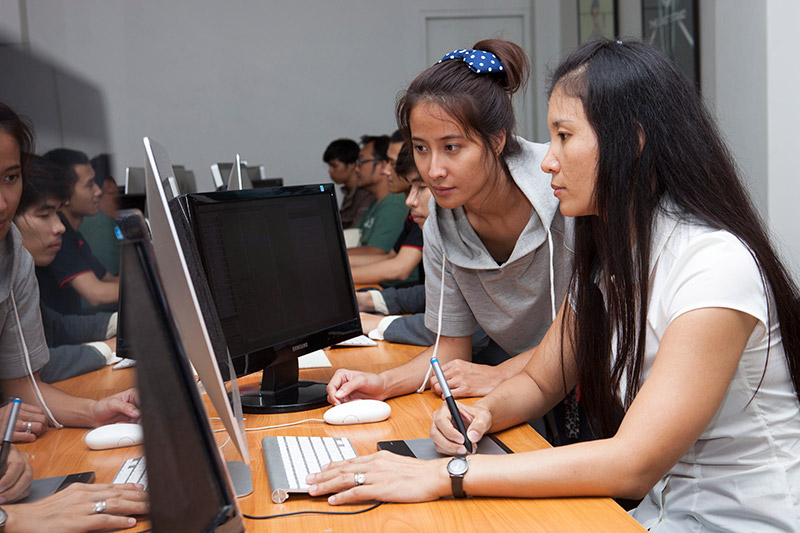Top: Mayura Sinlee Seagrave, at right, trains a Thai worker at multinational company Ultrafina. Photo: Sean Seagrave
By Michele Zack
In 2014, I returned to Dton Loong, one of Thailand’s most accessible Lisu villages located an hour’s drive north of Chiang Mai in rising countryside. I was looking for Alay-pa, an amiable headman I’d interviewed in 1997. The village had changed, the old bamboo and wood houses replaced by concrete ones, the former mud lanes paved. But it retained the familiar deserted feel of a village at midday; people were at work – some in fields, and today, some at jobs as far away as Chiang Mai. Many came home only on weekends, leaving behind snarling guard dogs. The day I visited, two minimally protected young men roved the village, section by section enveloping it in thick clouds of pesticide.
Some 1.5 million Lisu are spread across highland Southeast Asia today, united by language, custom and a distinct, skewed sense of humor perhaps developed to help them live with perpetual uneasiness. Their discomfort is born of generations of statelessness, frequent migration to avoid conflicts and Chinese domination, and outsider status.
Adjacent to Dton Loong, Lisu Lodge, one of Thailand’s first ethnic eco-resorts, was still in business. Established in 1992 and still operated by its original owner, the Lodge had scaled up a bit and joined a network of hostelries offering “hill tribe packages” to entertain education-minded tourists. Lisu Lodge provides service employment to local residents as hotel workers as well as singers, dancers and musicians performing in cultural shows. Workers dress traditionally, and they and the villagers make handicrafts to sell to guests. Tourism has become an important factor in preserving Lisu culture.
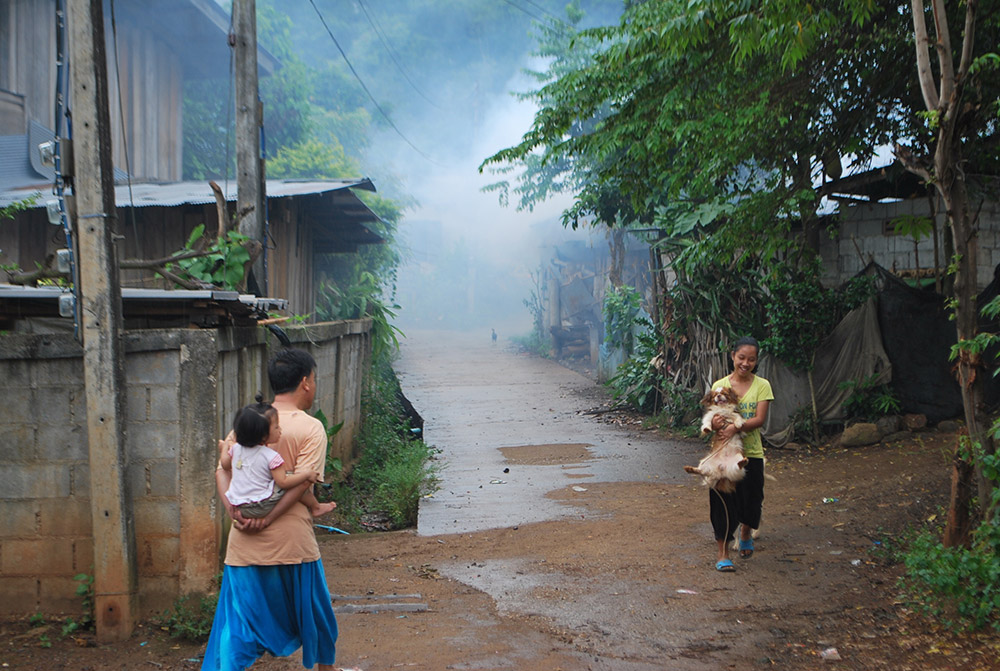
road and mosquito abatement program.
Development brings advantages and sometimes,
new health hazards. Photo: Michele Zack
I was disappointed not to find Alay-pa, but in my search I was directed to homes of other former headmen. At one, an older, energetic woman in Lisu dress beckoned me up to take a seat on the veranda of her sturdy concrete house. She sat overlooking the lane at a tabletop sewing machine surrounded by four or five giant multi-colored plastic bags and stacks of cloth. She was Ali-ma Loy-yee-pa, a member of the Sin-lee clan. She’d been married to a former headman, she said, but he’d taken up with another woman and moved away.
She gave a “what are you going do?” shrug. She was born here and had four daughters, but didn’t read or speak standard Thai well. She spoke Lisu for most needs and got by in the northern Thai dialect at the market in nearby Mae Malai.
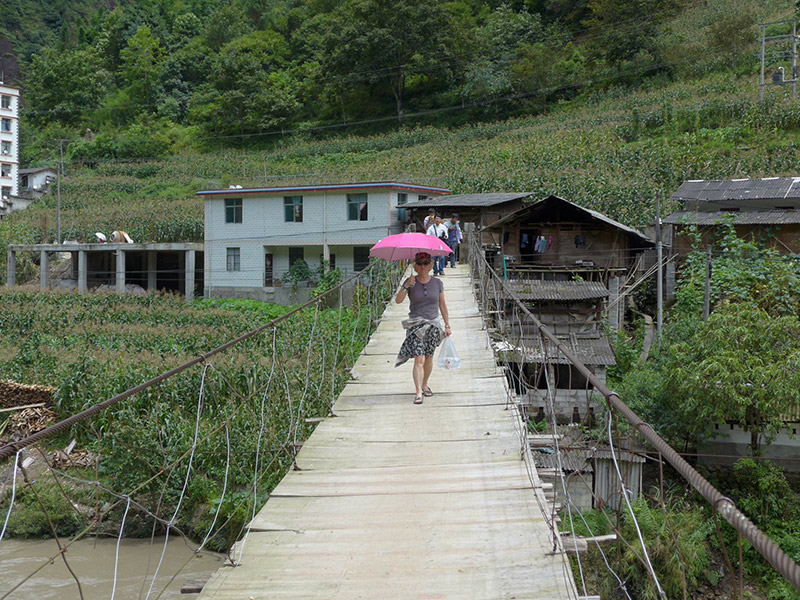
There and Back Again
For most of the 1990s, my husband, small daughter, and I lived in Thailand. The first four of our eight years here, we were illegal immigrants, an uneasy and traumatic state that we fortunately had the resources to resolve. I reported for AsiaWeek and the Far Eastern Economic Review, and in 1996 I was asked to write the first book-length ethnography of the Lisu tribe for a Thai-based publisher who was bringing out a series of beautifully photographed books on the hill tribes of Southeast Asia.
I jumped at the chance. I had known about the Lisu, the “anarchists of the highlands” since the mid-1980s when, as a budget tourist, I encountered them living far from roads and, it seemed, independent of the Thai government.
As it happened, my own immigration difficulties proved good psychological preparation for writing about a minority that has forever been on the run. Where the Lisu were originally running from is a matter of conflicting, contradictory theories; what is known is that over the past few hundred years they migrated from high remote valleys in the Upper Salween watershed of Yunnan China into what is now Myanmar, and finally, into northern Thailand. A few also live in Laos and the Arunachal Pradesh state of India.
In the mid-1990s, I spent two years researching and traveling to remote Lisu villages in Thailand, China’s Yunnan province and Myanmar. I consulted with Lisu scholars in Thailand and in the states and read everything written about them, 95 percent of which concerned the Thai Lisu, though they comprise only 5 percent of the total Lisu population. I finished the book, but before it was printed, the publisher went out of business. I returned to California in 1998.
Some 15 years later, I was still thinking about the Lisu. I revived the project with University of Colorado Press. By then, however, the world, especially Asia, had undergone convulsive modernization and change. My research was woefully out of date – so I returned to Asia to catch up with this egalitarian culture, focussing on comparing and updating Lisu adaptation in three countries with very different political and economic styles.
What I witnessed was something like a time-lapse display of globalization and its effects. In a few years, the Lisu had made the journey from stateless tribal minority to citizens in a new world economy. We’ve all made this trip, but most of us don’t remember because, in fact, our ancestors conducted it in stages over generations.
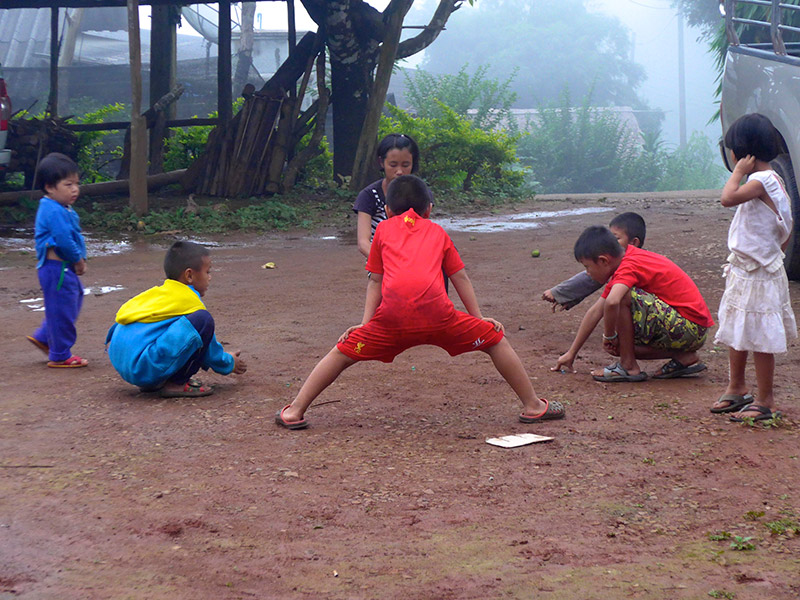
On my return to Dton Loong, Ali-ma, the Lisu divorcee, told me that things were much better today than 15 or 20 years ago. Her Lisu identity was stronger, her culture more protected. I asked for specifics. First, she said, is that Thai citizenship problems have been solved for most people in her village. Now, only recent immigrants from Burma struggle to gain identity cards. She described herself as a prosperous Thai citizen who was also proud to be Lisu. In the past, this wasn’t possible. She had a smartphone and held it up to show the village’s strong signal. She opened one of the large bags, revealing it to be full of the Lisu purses and bags she makes.
“I do it to keep busy, I don’t need the money,” she said. They were well made, small to big, with tiny colorful folded cloth triangles and squares stitched between multiple borders – a motif adapted from Lisu baby caps.
My eyes found a glass cabinet on the veranda overfilled with household objects and topped with a framed dusty photograph of a young woman and older Western man.
“Oh, “That is my eldest daughter, she lives in California,” Ali-ma explained, adding with a chuckle that all her daughters married foreigners. One was in New York, another in Osaka. Her youngest moved back to Chiang Mai a couple of years ago from Studio City, a Los Angeles suburb. On her cellphone, she showed me the telephone number of that daughter, Mayura, so I could jot it down. While she was at it, she pointed out her absent husband’s number in case I wanted to talk headman business with him. She was pleasant and matter of fact.
I, however, was nonplussed – smartphones with four bars, daughters in America, husband with a mia noi. This was my first day back in the field since 1998, and I’d forgotten how unabashed and friendly the Lisu are. That had not changed, nor had Lisu humor. Saying goodbye, Ali-Ma quipped that she’s thinking of taking up with a farang herself: Did I know a good one who’d like an old woman who had become just a little bit fat?
When I returned to Chiang Mai, I called her daughter, Mayura Sinlee Seagrave who, responding with “cool,” “yeah,” “okay,” – agreed to have dinner with me the following night.
She picked me up from my guesthouse in an SUV, the backseat strewn with the detritus of school-age children: orange peels, soccer jerseys, empty cups. Mayura didn’t sound as much like a Valley Girl in person as she had on the phone. Slim and attractive, with a cascade of shiny black hair, she wore a turquoise tunic over leggings and looked to be in her mid-20s rather than a 35-year-old soccer mom. She chose a hip vegetarian restaurant for dinner and told me her story:
“I grew up in Dton Loong but was sent to Suksasongkra boarding school in Chiang Mai when I was 7. . . the village school was no good. All the kids in my family got decent educations, because we lived so close to Chiang Mai. The school was fun, I liked living in the dormitory and meeting other hill tribe kids, just coming home on weekends. My father was a successful headman and farmer, also a silversmith. He attended ag school, and took classes in things like composting, planting rice between fruit trees, and raising pigs efficiently. Because he was headman, he got involved in economic development. Some Lisu didn’t understand the importance of Thai citizenship. He “got it” earlier than many and moved ahead. For older, poorer people it was hard – too much work. You had to walk a whole day to renew your ID. You had to pay money, be insulted, and many just didn’t do it. And it was actually not so bad in our village, we live closer to government offices than most. Even before Lisu Lodge, foreigners came there and we were exposed to modern things.
“My dad tried to steer me to ag, but I wasn’t into it. Choosing not to go to University, I took a vocational course in sewing instead. Later, I realized it was important, and did a distance learning course through Sukhothai Open University. They send you books, you study anywhere, just turn up to take tests. I got a bachelor’s degree in English. Now I’m trying to get a biz degree, but it is hard with two kids and working in the family business.
“I met my husband Sean 15 years ago in Chiang Mai, when I worked at an internet café. His background is Burmese-American, and his family has lived in Asia for five generations. His parents are both writers. My husband and I have a graphic photography and retouching company, Ultrafina and do advertising for cosmetics, movie posters, and so on. It’s U.S.-based, and first we lived in New York. It was too cold there, though. Then we moved to Studio City in LA for a few years. But after the second kid (her children are now 8 and 14) it was easier to come back to Chiang Mai. We moved here in 2009 to be closer to my mother, for good schools, and because household help is better here. Because we live here, my kids can understand, and one even speaks some Lisu. At home we use English and Thai.”
I asked Mayura if she felt Lisu.
“It’s me, of course. I feel kind of happy to be Lisu, but also Northern Thai, Buddhist, animist, and some American. I also feel good about the opportunities I’ve had to learn and to travel — not just stay in the village like my mother.”
Her sisters, she said, had all married foreigners much older than they and also left the village. As a young girl, she’d thought she would follow their examples: “Marry an older guy, have a peaceful life.”
This was a practical matter: She didn’t judge her parents for allowing her eldest sister, at 16, to marry a man near 60. The age difference wasn’t important. Unlike her parents, whose marriage ended in a divorce that was hard on the family, her sister was still happily married (today, she is in her 40s, her husband in his 80s).
Mayura said her father had picked up “Thai ideas” from involvement with government officials – especially that men have more power than women.
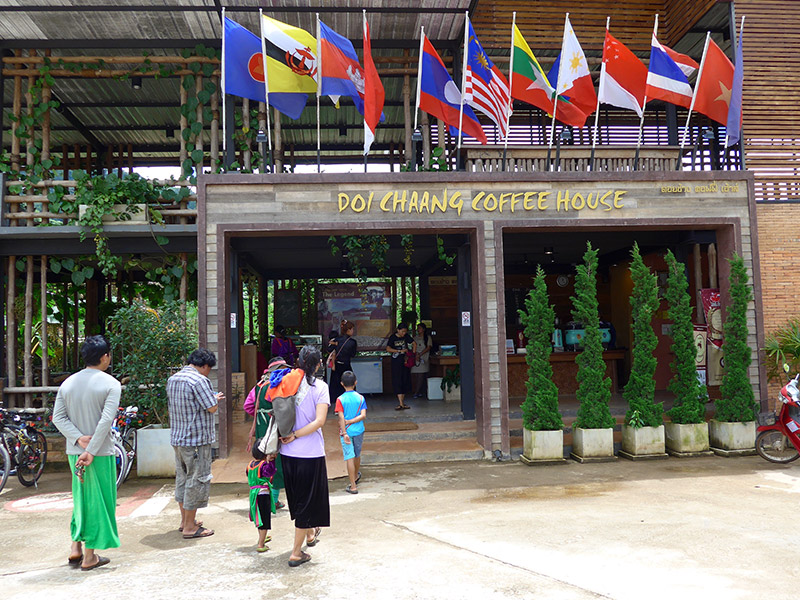
In the standard Thai way of showing success, he took a younger second wife, or mia noi. This practice was antithetical to Lisu values, which hold woman and men as equals. Divorce exists, but taking a mia noi is not part of Lisu culture and her mother would not accept it. This caused terrible fights. Her father divorced her mother but still supports her financially.
Today, Mayura, as the only daughter living close by, sees her mother regularly and encourages her to branch out in the things she makes, to “move into backpacks, and other useful things people need and like.”
I asked Mayura if her father received a bride price for her. This practice persists among both animist and Christian Lisu, though many Christians have dropped it – or claim they have. Mayura’s family are not Christians, however, and like every Lisu woman everywhere, she remembers the exact amount: “Father took 50,000 baht for each of us daughters (then worth about USD$1,300) to keep everyone equal,” she said. “But I think he turned around and spent it all on our wedding feasts.” Mayura’s husband was 11 years older, not a significant difference, she said. Cultural conflict had not been a big issue for them: “Marriage is hard for all couples sometimes, but we are together, we work together at our company. Our kids are happy, our family is good.”
Mayura, whose mother is illiterate (but has clearly held on to her myi-do) and father used the advantages of being headman to advance, has used her own agency in moving from tribal village girl to international businesswoman in one generation.
On that first day back in the field, it became clear to me that my book would be more than a traditional ethnography. Indeed, “The Lisu: Far from the Ruler” is both narrow and deep, the story of one remote, lively, anarchic group’s journey across time and into today’s global economy – illuminating the benefits, trade-offs, choices and losses all modern people make on the way to becoming subjects of a state and participants in the new world order.
This article is adapted from Michele Zack’s latest book, ”The Lisu: Far From the Ruler,” University Press of Colorado, 2017. It’s available in Thailand from most online book sellers, Amazon.com and the publisher.
Michele Zack can be reached at [email protected]. She will be in Thailand to present at an International Lisu meeting Feb. 23-25 at Ban Pang Mai Deng in Chiang Mai’s Mae Taeng district. She will also speak in Bangkok on Feb. 14 at the Foreign Correspondents Club of Thailand and Feb. 15 at the Siam Society.


































